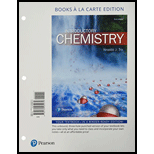
Concept explainers
Data Interpretation and Analysis
Read CHEMISTRY IN THE ENVIRONMENT: Water Pollution and the Flint River Water Crisis at the end of Section 12.8. The table shown here features a set of data on lead levels in drinking water in Flint, Michigan, collected by the Virginia Tech team described in the box. The lead levels in water are expressed in units of parts per billion (ppb), which is a way of reporting solution concentration that is similar to mass percent. Mass percent is the number of grams of solute per 100 grams solution, while ppb is the number of grams of solute per
| Sample # | Lead level first draw (ppb) | Lead level 45-sec flush (ppb) | Lead level 2-min flush (ppb) |
| 1 | 0.344 | 0.266 | 0.145 |
| 2 | 8.133 | 10.77 | 2.761 |
| 3 | 1.111 | 0.11 | 0.123 |
| 4 | 8.007 | 7.446 | 3.384 |
| 5 | 1.951 | 0.048 | 0.035 |
| 6 | 7.2 | 1.4 | 0.2 |
| 7 | 40.63 | 9.726 | 6.132 |
| 8 | 1.1 | 2.5 | 0.1 |
| 9 | 10.6 | 1.038 | 1.294 |
| 10 | 6.2 | 4.2 | 2.3 |
| 11 | 4.358 | 0.822 | 0.147 |
| 12 | 24.37 | 8.796 | 4.347 |
| 13 | 6.609 | 5.72 | 1.433 |
| 14 | 4.062 | 1.099 | 1.085 |
| 15 | 29.59 | 3.258 | 1.843 |
Lead Levels in Flint Tap Water
Source: FlintWaterStuo‘y org (2015) JLead Results from Tap Water Sampling in Flint, MI during the Flint Water Crisis"
(a) Determine the average value of lead for first draw, 45-second flush, and 2-minute flush (round to three significant figures). (b) Do the data support the idea that running the tap water before taking a sample made the lead levels in the water appear lower? Why might this be the case?
(c) The EPA requires water providers to monitor drinking water at customer taps. If lead concentrations exceed 15 ppb in 10% or more of the taps sampled, the water provider must notify the customer and take steps to control the corrosiveness of the water. If the water provider in Flint had used first-draw samples to monitor lead levels, would it have been required to take action by EPA requirements? If the Flint water provider used 2-minute flush samples, would it have had to take action? Which drawing technique do you think more closely mimics the way residents actually use their water? (d) Using the highest value of lead from the first-draw data set, and assuming a resident drinks 2 L of water per day, calculate the mass of lead that the resident would consume over the course of 1 year. (Assume the water has a density of 1-0 g/mL.)
Trending nowThis is a popular solution!
Learn your wayIncludes step-by-step video

Chapter 13 Solutions
Introductory Chemistry, Books a la Carte Plus Mastering Chemistry with Pearson eText -- Access Card Package (6th Edition)
Additional Science Textbook Solutions
Biology: Life on Earth (11th Edition)
Biology: Life on Earth with Physiology (11th Edition)
Genetic Analysis: An Integrated Approach (3rd Edition)
Physics for Scientists and Engineers: A Strategic Approach, Vol. 1 (Chs 1-21) (4th Edition)
Campbell Biology (11th Edition)
Anatomy & Physiology (6th Edition)
- Briefly state the electrocapillary equation for ideally polarized electrodes.arrow_forwardWhat is surface excess according to the Gibbs model?arrow_forwardUsing Benzene as starting materid show how each of the Following molecules Contel Ve syntheswed CHI 9. b -50311 с CHY 503H Ночто d. อ •NOV e 11-0-650 NO2arrow_forward
- The molecule PYRIDINE, 6th electrons and is therefore aromatre and is Assigned the Following structure contering Since aromatk moleculoy undergo electrophilic anomatic substitution, Pyridine shodd undergo The Following reaction + HNO3 12504 a. write all of the possible Mononitration Products that could Result From this reaction 18. Bared upon the reaction mechanison determime which of these producty would be the major Product of the hegetionarrow_forwarda. Explain Why electron withdrawing groups tend to be meta-Directors. Your answer Should lyclude all apropriate. Resonance contributing Structures fo. Explain why -ll is an outho -tura drccton even though chlorine has a very High Electronegativityarrow_forward9. Write Me product as well as the reaction Mechanism For each of the Following Vanctions +H₂504 4.50+ T C. +212 Fellz 237 b. Praw the potential energy Diagrams For each OF Mese Rauctions and account For any differences that appear in the two potential Puergy Diagrams which of here two reactions 19 Found to be Reversable, Rationalice your answer based upon the venation mechanisms and the potential energy diagrams.arrow_forward
- 9. Write Me product as well as the reaction Mechanism For each of the Following Veritious +H2504 4.50+ + 1/₂ Felly ◎+ 7 b. Praw he potential energy Diagrams For each OF Mese Ronctions and account for any differences that appeak in the two potential Puergy Diagramsarrow_forwardDraw the major product of this reaction. Ignore inorganic byproducts. Incorrect, 3 attempts remaining 1. excess Br2, NaOH 2. neutralizing workup Qarrow_forwardGiven the electrode Pt | Ag | Ag+ (aq), describe it.arrow_forward
 Chemistry & Chemical ReactivityChemistryISBN:9781337399074Author:John C. Kotz, Paul M. Treichel, John Townsend, David TreichelPublisher:Cengage Learning
Chemistry & Chemical ReactivityChemistryISBN:9781337399074Author:John C. Kotz, Paul M. Treichel, John Townsend, David TreichelPublisher:Cengage Learning Chemistry: The Molecular ScienceChemistryISBN:9781285199047Author:John W. Moore, Conrad L. StanitskiPublisher:Cengage Learning
Chemistry: The Molecular ScienceChemistryISBN:9781285199047Author:John W. Moore, Conrad L. StanitskiPublisher:Cengage Learning Introductory Chemistry: An Active Learning Approa...ChemistryISBN:9781305079250Author:Mark S. Cracolice, Ed PetersPublisher:Cengage Learning
Introductory Chemistry: An Active Learning Approa...ChemistryISBN:9781305079250Author:Mark S. Cracolice, Ed PetersPublisher:Cengage Learning- Chemistry: Matter and ChangeChemistryISBN:9780078746376Author:Dinah Zike, Laurel Dingrando, Nicholas Hainen, Cheryl WistromPublisher:Glencoe/McGraw-Hill School Pub Co
 General, Organic, and Biological ChemistryChemistryISBN:9781285853918Author:H. Stephen StokerPublisher:Cengage Learning
General, Organic, and Biological ChemistryChemistryISBN:9781285853918Author:H. Stephen StokerPublisher:Cengage Learning Chemistry & Chemical ReactivityChemistryISBN:9781133949640Author:John C. Kotz, Paul M. Treichel, John Townsend, David TreichelPublisher:Cengage Learning
Chemistry & Chemical ReactivityChemistryISBN:9781133949640Author:John C. Kotz, Paul M. Treichel, John Townsend, David TreichelPublisher:Cengage Learning





